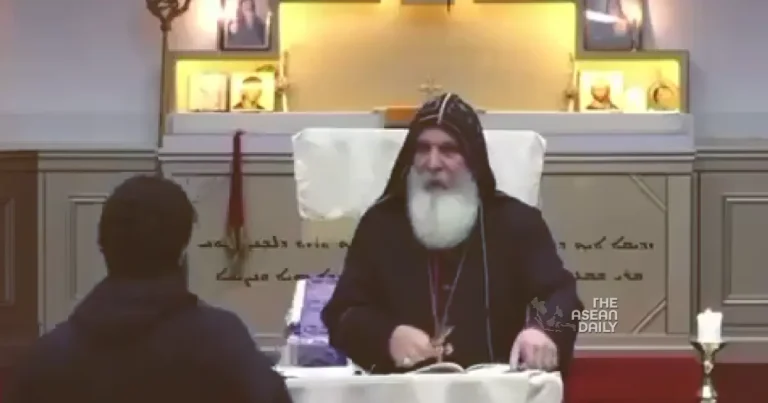17-4-2024 (SYDNEY) In the wake of the harrowing knife attacks that have gripped Sydney over the past week, a pivotal question arises: what truly separates an act of terrorism from a violent outburst fueled by personal demons? As the dust settles and investigations unfold, the distinction between these two grim realities becomes increasingly blurred, forcing us to confront the nuances that define such heinous acts.
The city’s collective breath was stolen on Monday evening when a 16-year-old assailant stormed into an Assyrian church, viciously stabbing a prominent bishop and a priest who valiantly rushed to his defence. The chilling sequence of events was captured on the church’s video stream, swiftly disseminating through Sydney’s vast Assyrian community and igniting a firestorm of shock and grief.
While the wounded clergymen thankfully survived the brutal assault, the emotional scars inflicted upon the congregation and the broader community are sure to linger. In a cruel twist of fate, this attack closely followed the devastating rampage at Westfield Bondi Junction merely days prior, where a lone attacker claimed the lives of six innocent individuals, leaving an indelible mark on the city’s collective psyche.

As the authorities swiftly identified the church attacker and delved into his potential motivations, a pivotal determination was made – this incident would be treated as an act of terrorism. Simultaneously, the Bondi Junction massacre, despite its staggering toll, was not classified as such, igniting a contentious discourse around the definitions and distinctions that govern these classifications.
The crux of the matter lies in the perceived motivations behind each act. According to law enforcement, the Bondi Junction killer, Joel Cauchi, was driven by anger control issues stemming from mental ill-health, rather than a broader political or ideological agenda. However, the targeting of predominantly women during his rampage has raised questions about whether misogyny, a deeply rooted societal scourge, should be viewed through the lens of terrorism.
On the other hand, the church attack appears to have been meticulously planned, potentially influenced by external forces or ideologies. The symbolic targeting of an Assyrian Christian community, a group that has endured unspeakable persecution at the hands of extremist organisations like the Islamic State, lends credence to the suspicion of a broader, sinister agenda.
Yet, in the midst of this harrowing discourse, a fundamental question emerges: does the label of “terrorism” truly hold more weight or significance than the sheer brutality of the acts themselves? Or is it merely a matter of conceptual clarity, a means of categorising the motives behind such atrocities for the sake of guiding investigations?
The lines between personal demons and ideological zealotry are often blurred, intertwined in a complex tapestry of hatred and violence. Misogyny, while undoubtedly a societal ill, may not always be tied to a broader political or religious movement – but it can certainly be an integral component of such ideologies. Conversely, mental health issues can be exploited and amplified by extremist rhetoric, creating a volatile cocktail of instability and radicalisation.
Perhaps the true crux of the matter lies not in the semantics of “terrorism” versus “violent outburst,” but in the collective failure to address the root causes that breed such hatred and violence. Whether driven by personal demons or extremist ideologies, these acts are symptomatic of a deeper malaise that plagues our society – a malaise that transcends labels and classifications.
The trauma inflicted upon the Assyrian community in Sydney is a stark reminder of the lingering scars left by the atrocities committed by the Islamic State. For a community that has endured unimaginable persecution and displacement, the church attack is a visceral reminder of the ever-present threat of extremism and the vulnerability of minority groups.
Yet, even in the face of such adversity, the resilience and unity of the Assyrian diaspora shine through. Their unwavering faith and commitment to their cultural and religious identity serve as a defiant rebuke to those who seek to sow seeds of fear and division.
As the investigations into these attacks progress, it is imperative that we maintain a nuanced and empathetic perspective. While the legal and procedural distinctions between terrorism and other violent crimes are necessary for law enforcement purposes, we must not lose sight of the human toll exacted by such acts.
Each life lost, each wound inflicted, carries with it a profound ripple effect that reverberates through families, communities, and the fabric of society itself. The pain and anguish experienced by the victims and their loved ones transcend labels and classifications, serving as a poignant reminder of the fragility of life and the imperative to protect and cherish it.
In the aftermath of these tragedies, it is incumbent upon us to engage in meaningful dialogue and collective introspection. We must confront the societal ills that enable and perpetuate hatred, whether they manifest as extremist ideologies or deep-seated biases. Only by addressing the root causes can we hope to stem the tide of violence that threatens to engulf our communities.
Ultimately, the blurred lines between terrorism and violent outbursts should not distract us from the shared goal of fostering a more just, compassionate, and inclusive society. Whether driven by personal demons or ideological zealotry, these acts are a clarion call for unity, empathy, and a steadfast commitment to upholding the values of human dignity and respect.




